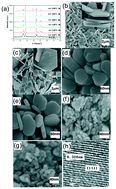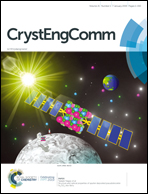Low-temperature route to prepare rare earth fluorides in a molten NH4NO3 system: a systematic study on the effects of NaF/Ln ratio and the reaction temperature and time†
Abstract
A low-temperature strategy has been applied to synthesize a host of rare earth fluorides including NaLnF4 and LnF3 (Ln = rare earth) with NaF and rare earth nitrates as initial raw materials in NH4NO3 flux. It is found that the crystal structures and shape evolutions of rare earth fluorides are highly sensitive to the rare earth ions, NaF/Ln molar ratio, reaction temperature and reaction time. Based on their crystallization behavior, the rare earth fluorides can be divided into four groups. Group I (La and Ce)-based LnF3 exhibits the trigonal tysonite type of structure (P![[3 with combining macron]](https://www.rsc.org/images/entities/char_0033_0304.gif) c1). The small particles are generally spherical, whereas the well matured particles have taken on plate-like shape. Group II (Pr and Nd)-based fluorides crystalize in hexagonal LnF3 with changeable shapes (quasisphere, embryonic rod form, short prism, small rods), and high reaction temperature, long reaction time and large NaF/Ln ratio are favorable for the formation of large hexagonal NaLnF4 rods. For group III (Sm, Eu, Gd, Tb, Dy and Ho), the transformation from orthorhombic LnF3 nanopolyhedra to hexagonal LnF3 nanorods occurs at a low reaction temperature when the NaF/Ln molar ratio increases from three to six, whereas the extension of reaction time and the enhancement of reaction temperature induce the production of hexagonal-phased NaLnF4 rod-like particles. Group IV (Y, Er, Tm, Yb and Lu)-based rare earth fluorides prefer to form orthorhombic LnF3 polyhedra at a low NaF/Ln molar ratio of three, whereas increasing the NaF/Ln molar ratio to six produces quasisphere-like cubic NaLnF4 particles, and the extended reaction time and increase in reaction temperature result in hexagonal NaLnF4 rods through Ostwald ripening. The general trend of stable phase and shape evolution of rare earth fluorides can be ascribed to the lanthanide contraction effect and the activation energy barrier to shape transformation.
c1). The small particles are generally spherical, whereas the well matured particles have taken on plate-like shape. Group II (Pr and Nd)-based fluorides crystalize in hexagonal LnF3 with changeable shapes (quasisphere, embryonic rod form, short prism, small rods), and high reaction temperature, long reaction time and large NaF/Ln ratio are favorable for the formation of large hexagonal NaLnF4 rods. For group III (Sm, Eu, Gd, Tb, Dy and Ho), the transformation from orthorhombic LnF3 nanopolyhedra to hexagonal LnF3 nanorods occurs at a low reaction temperature when the NaF/Ln molar ratio increases from three to six, whereas the extension of reaction time and the enhancement of reaction temperature induce the production of hexagonal-phased NaLnF4 rod-like particles. Group IV (Y, Er, Tm, Yb and Lu)-based rare earth fluorides prefer to form orthorhombic LnF3 polyhedra at a low NaF/Ln molar ratio of three, whereas increasing the NaF/Ln molar ratio to six produces quasisphere-like cubic NaLnF4 particles, and the extended reaction time and increase in reaction temperature result in hexagonal NaLnF4 rods through Ostwald ripening. The general trend of stable phase and shape evolution of rare earth fluorides can be ascribed to the lanthanide contraction effect and the activation energy barrier to shape transformation.



 Please wait while we load your content...
Please wait while we load your content...